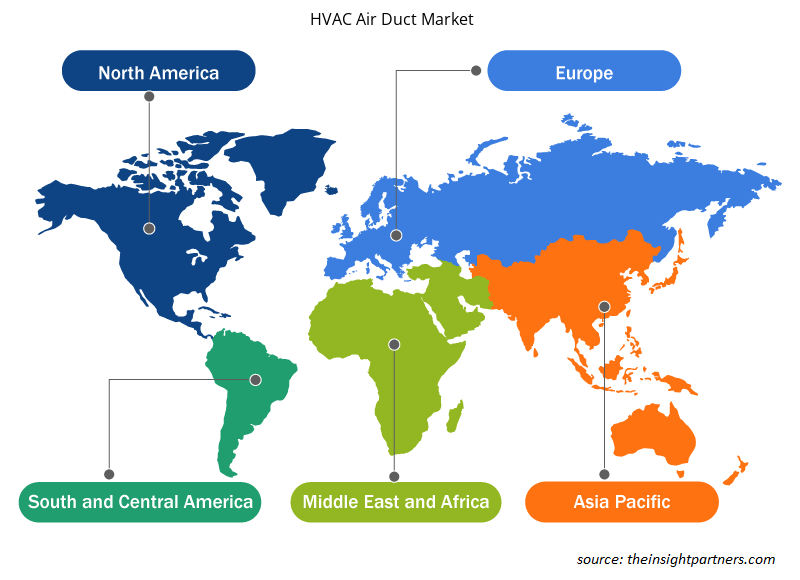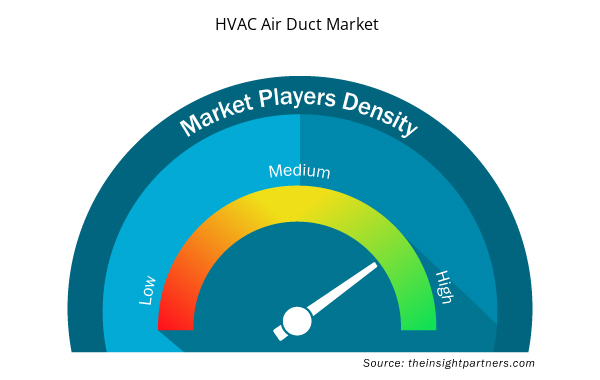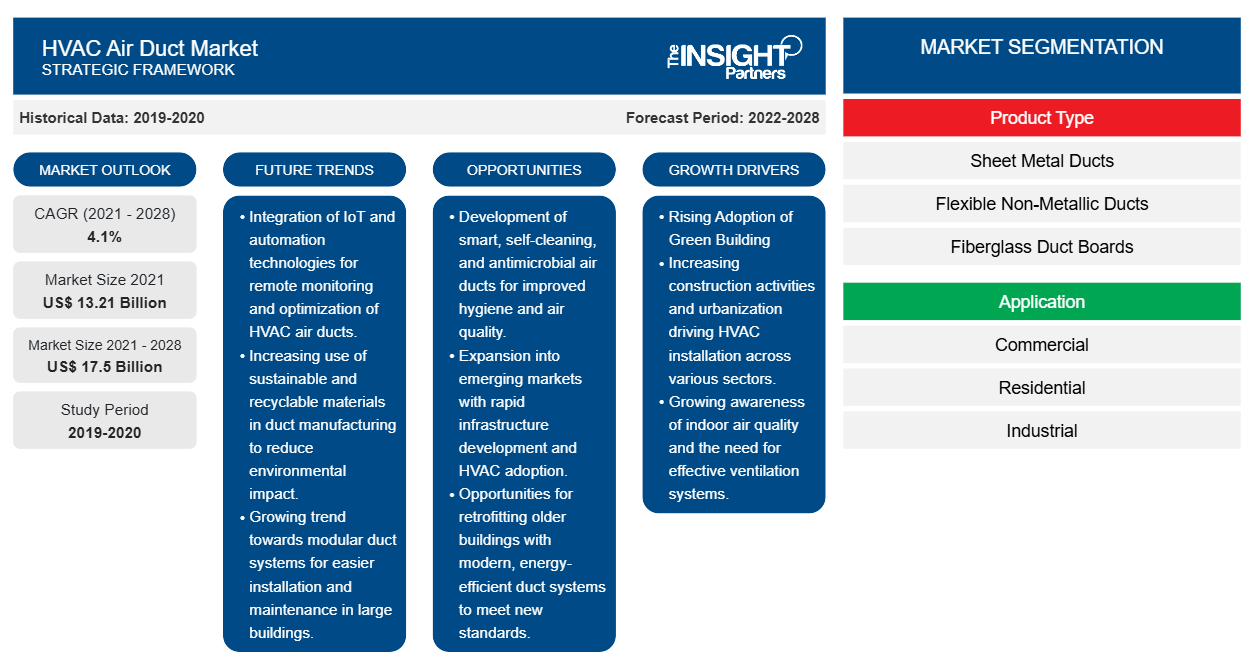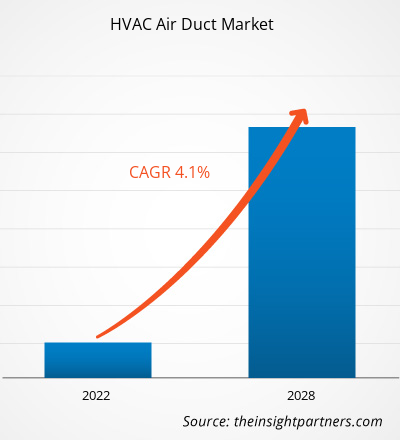Il mercato dei condotti dell'aria HVAC è stato valutato a 13.213,7 milioni di dollari nel 2021 e si prevede che raggiungerà i 17.502,6 milioni di dollari entro il 2028; si prevede una crescita a un CAGR del 4,1% dal 2021 al 2028.
La crescente inclinazione verso la tecnologia degli edifici verdi e il crescente numero di data center stanno spingendo la crescita del mercato dei condotti dell'aria HVAC. Gli edifici verdi offrono molti vantaggi economici o finanziari, che sono rilevanti per una serie di persone o gruppi di persone diversi. Con la crescente adozione di edifici verdi in paesi come Stati Uniti, Canada, Germania, Regno Unito, Cina e altri, la domanda di sistemi HVAC avanzati è in forte aumento. Molti architetti e governi del settore residenziale e commerciale implementano la tecnologia degli edifici verdi grazie ai suoi vari vantaggi, come maggiore efficienza energetica, minori impronte di carbonio e impatto ridotto sull'ambiente. Questo fattore sta catalizzando la domanda di sistemi HVAC, che sta successivamente aumentando la crescita del mercato dei condotti dell'aria HVAC . Inoltre, il crescente numero di data center in tutto il mondo sta spingendo la domanda di sistemi HVAC e successivamente guidando la crescita del mercato dei condotti dell'aria HVAC. Inoltre, la crescente applicazione di pompe di calore geotermiche (GHP) in edifici residenziali e commerciali sta offrendo opportunità redditizie per i produttori di condotti dell'aria HVAC. Questa tecnologia è ampiamente utilizzata per il riscaldamento e il raffreddamento degli edifici e si prevede che la sua ampia accettazione aumenterà la domanda di condotti dell'aria HVAC nei prossimi anni.
Personalizza questo report in base alle tue esigenze
Riceverai la personalizzazione gratuita di qualsiasi report, comprese parti di questo report, o analisi a livello nazionale, pacchetto dati Excel, oltre a usufruire di grandi offerte e sconti per start-up e università
- Scopri le principali tendenze di mercato in questo rapporto.Questo campione GRATUITO includerà analisi di dati che spaziano dalle tendenze di mercato alle stime e alle previsioni.
Impatto della pandemia di COVID-19 sul mercato dei condotti dell'aria HVAC
La pandemia di COVID-19 ha colpito la maggior parte delle aziende in tutto il mondo. La continua crescita del numero di pazienti infetti dal virus ha costretto le autorità governative di vari paesi a limitare i movimenti di persone, beni e materie prime imponendo restrizioni di viaggio, blocchi di massa e chiusure aziendali. L'imposizione del blocco ha comportato una minore produzione di materie prime e beni e ha ridotto la frequenza delle offerte di servizi. I settori manifatturiero, automobilistico, dei semiconduttori e dell'elettronica, del petrolio e del gas, dell'aviazione, minerario e altri hanno assistito a un notevole calo dei loro ricavi a causa della chiusura temporanea delle operazioni. Nel primo trimestre del 2020, dopo l'imposizione del blocco nazionale nella maggior parte delle nazioni, molti settori industriali si sono fermati. Il condotto dell'aria HVAC è ampiamente utilizzato nei laboratori e in vari settori come quello farmaceutico, alimentare, elettronico e dei semiconduttori e manifatturiero. Anche la domanda di condotti dell'aria HVAC in varie piccole e medie imprese è stata influenzata negativamente.Tuttavia, una volta che la situazione tornerà alla normalità, si prevede che il mercato dei condotti dell'aria HVAC crescerà notevolmente in tutto il mondo durante il periodo di previsione.
Approfondimenti di mercato – Mercato dei condotti dell'aria HVAC
Crescente adozione di edifici ecosostenibili
Con la crescente adozione di edifici verdi in paesi come Stati Uniti, Canada, Germania, Regno Unito, Cina e altri e l'uso di metodi di riscaldamento e raffreddamento geotermici dovuti all'aumento della domanda di sistemi HVAC. I vantaggi associati alla tecnologia degli edifici verdi, come maggiore efficienza energetica, minori emissioni di carbonio e impatto ridotto sull'ambiente, stanno attraendo molti architetti e governi del settore residenziale e commerciale a implementare questa tecnologia. Questo fattore sta catalizzando la domanda di sistemi HVAC, che sta successivamente incrementando il mercato dei condotti dell'aria HVAC. Inoltre, gli edifici verdi commerciali stanno cercando un volume maggiore di sistemi HVAC eco-compatibili per ridurre la loro dipendenza dai prodotti petroliferi.
Informazioni basate sul tipo di prodotto
In base al tipo di prodotto, il mercato dei condotti dell'aria HVAC è segmentato in condotti in lamiera, condotti flessibili non metallici, pannelli per condotti in fibra di vetro e altri. Il segmento dei condotti in lamiera ha detenuto la quota di mercato maggiore nel 2021.
Gli operatori che operano nel mercato dei condotti dell'aria HVAC si concentrano principalmente sullo sviluppo di prodotti avanzati ed efficienti.
- Nell'aprile 2020, DuctSox, noto produttore di sistemi di dispersione dell'aria e condotti in tessuto, ha prodotto sistemi di condotti in tessuto che possono essere utilizzati per le tende mediche durante la pandemia di COVID-19.
Approfondimenti regionali sul mercato dei condotti dell'aria HVAC
Le tendenze regionali e i fattori che influenzano il mercato dei condotti dell'aria HVAC durante il periodo di previsione sono stati ampiamente spiegati dagli analisti di Insight Partners. Questa sezione discute anche i segmenti e la geografia del mercato dei condotti dell'aria HVAC in Nord America, Europa, Asia Pacifico, Medio Oriente e Africa e America meridionale e centrale.

- Ottieni i dati specifici regionali per il mercato dei condotti dell'aria HVAC
Ambito del rapporto sul mercato dei condotti dell'aria HVAC
| Attributo del report | Dettagli |
|---|---|
| Dimensioni del mercato nel 2021 | 13,21 miliardi di dollari USA |
| Dimensioni del mercato entro il 2028 | 17,5 miliardi di dollari USA |
| CAGR globale (2021 - 2028) | 4,1% |
| Dati storici | 2019-2020 |
| Periodo di previsione | 2022-2028 |
| Segmenti coperti | Per tipo di prodotto
|
| Regioni e Paesi coperti | America del Nord
|
| Leader di mercato e profili aziendali chiave |
|
Densità dei protagonisti del mercato dei condotti dell'aria HVAC: comprendere il suo impatto sulle dinamiche aziendali
Il mercato dei condotti dell'aria HVAC sta crescendo rapidamente, spinto dalla crescente domanda degli utenti finali dovuta a fattori quali l'evoluzione delle preferenze dei consumatori, i progressi tecnologici e una maggiore consapevolezza dei vantaggi del prodotto. Con l'aumento della domanda, le aziende stanno ampliando le loro offerte, innovando per soddisfare le esigenze dei consumatori e capitalizzando sulle tendenze emergenti, il che alimenta ulteriormente la crescita del mercato.
La densità degli operatori di mercato si riferisce alla distribuzione di aziende o società che operano in un particolare mercato o settore. Indica quanti concorrenti (operatori di mercato) sono presenti in un dato spazio di mercato in relazione alle sue dimensioni o al valore di mercato totale.
Le principali aziende che operano nel mercato dei condotti dell'aria HVAC sono:
- Fabbricazione di lamiere Tin Man, LLC
- Fabbricanti di metalli Hennemuth
- Azienda
- DuctSox
- Lindab
Disclaimer : le aziende elencate sopra non sono classificate secondo un ordine particolare.

- Ottieni una panoramica dei principali attori del mercato dei condotti dell'aria HVAC
Il mercato dei condotti dell'aria HVAC è stato segmentato come segue:
Mercato dei condotti dell'aria HVAC - per tipo di prodotto
- Condotti in lamiera
- Condotti flessibili non metallici
- Pannelli per condotti in fibra di vetro
- Altro
Mercato dei condotti dell'aria HVAC - per applicazione
- Residenziale
- Commerciale
- Industriale
Mercato dei condotti dell'aria HVAC – per area geografica
America del Nord
- NOI
- Canada
- Messico
Europa
- Germania
- Francia
- Regno Unito
- Russia
- Resto d'Europa
Asia Pacifico (APAC)
- Cina
- India
- Giappone
- Corea del Sud
- Resto dell'APAC
Medio Oriente e Africa
- Sudafrica
- Arabia del Sud
- Emirati Arabi Uniti
- Resto del MEA
Sud America
- Brasile
- Argentina
- Resto del SAM
Mercato dei condotti dell'aria HVAC – Profili aziendali
- TIN MAN FABBRICAZIONE LAMIERA, LLC
- Fabbricanti di metalli Hennemuth
- Azienda
- DuctSox
- Lindab
- Sistemi di condotti chiavi in mano
- Produzione di M&M
- Imposta condotto
- Condotto USA
- ACCIAIO VK
- Analisi storica (2 anni), anno base, previsione (7 anni) con CAGR
- Analisi PEST e SWOT
- Valore/volume delle dimensioni del mercato - Globale, regionale, nazionale
- Industria e panorama competitivo
- Set di dati Excel


- Equipment Rental Software Market
- Bioremediation Technology and Services Market
- Gas Engine Market
- Retinal Imaging Devices Market
- Aircraft Landing Gear Market
- Wire Harness Market
- Artificial Intelligence in Healthcare Diagnosis Market
- Microcatheters Market
- Playout Solutions Market
- Artwork Management Software Market

Report Coverage
Revenue forecast, Company Analysis, Industry landscape, Growth factors, and Trends

Segment Covered
This text is related
to segments covered.

Regional Scope
North America, Europe, Asia Pacific, Middle East & Africa, South & Central America

Country Scope
This text is related
to country scope.
Domande frequenti
The growing application of Geothermal Heat Pumps (GHP) across residential and commercial buildings is providing lucrative opportunities for HVAC air ducts manufacturers. Geothermal heat pumps are gaining popularity in the market, owing to their highly efficient renewable energy technology, which provides both heating and cooling by using stable temperatures from the earth. A GHP system is a central heating or cooling system that pumps heat to or from the ground.
Green buildings offer several economic or financial benefits, which are relevant to a range of different people or groups of people. Green building (GB) constructions seeks to address housing demands of the growing populace with better qualities, energy efficiency, using recycled and recyclable materials, improve building lifespan and health of occupants. The building sector has the largest potential for significantly reducing greenhouse gas emissions compared to other major emitting sectors.
The sheet metal ducts are rigid air ducts and are available in different sizes and shapes, such as rectangular and cylindrical. Sheet metal duct is rigid in structure which gives the advantage of less risk of kinks or bends. However, the rigidity makes it less suitable for tight or tricky spaces. Sheet metal ducts are made from either galvanized steel or aluminum. Mold resistant nature of the nonporous material used in sheet metal ducts is the prominent factor driving the market growth. Also, easy to clean smooth surfaces, durability, and lightweight are the leading factors propelling the market growth. The availability of advanced ductwork designing software and fabricated sheet metal as per requirement demand for sheet metal ducts is flourishing in commercial and residential sectors. Increasing demand for HVAC systems in the commercial industry in the US is supporting the market growth.
The residential sector is among the prominent arenas to adopt HVAC systems. The demand for residential air conditioning has been consistently surging over the years, and the trend is anticipated to continue in the coming years. This is foreseen to continue to support the growth of the HVAC air ducts market. Moreover, the construction of residential (both single-family homes and apartment buildings) showcases an upward trend in the US nations. The installation of HVAC in the residential sector is among the residents' top priorities, and due to the rising construction activities, the demand for HVAC would surge. This is anticipated to boost the HVAC air ducts market from the residential sector. For instance, the US residential sector consumed ~236 billion kWh of electricity in 2020 for cooling, which is 6% of the total US electricity consumption.
The evolving technology in HVAC systems is expected to spur the demand for HVAC air ducts soon. The rising adoption of advanced technologies such as the internet of things (IoT) in HVAC systems is expected to fuel the growth of the HVAC air ducts market during the forecast period. The new HVAC technologies which use IoT are embedded with sensors, software that enables the HVAC system to exchange data with other connected devices. IoT systems are expected to improve preventative maintenance by sensing data on air quality and equipment status. The IoT technology will also bring more automation in HVAC systems by integrating their functions with other virtual assistant devices such as Alexa to change the temperature through the voice.
The Asia-Pacific HVAC air ducts market is growing due to growing industrialization, increase in disposable income of the consumers, rising demand for luxury products, and stringent government norms focusing on global warming are the factors that is expected to drive the growth of the segment. Growing construction sector in countries such as China and India, which are witnessing huge investments in the infrastructure sector, specifically for retail spaces, commercial office buildings, manufacturing facilities, metro rail lines, and expansion and construction of airports. This attribute increasing commercial construction projects along with expansion in the number of shopping complexes and retail stores will significantly fuel the demand for HVAC air ducts in the region.
Trends and growth analysis reports related to Electronics and Semiconductor : READ MORE..
The Insight Partners performs research in 4 major stages: Data Collection & Secondary Research, Primary Research, Data Analysis and Data Triangulation & Final Review.
- Data Collection and Secondary Research:
As a market research and consulting firm operating from a decade, we have published and advised several client across the globe. First step for any study will start with an assessment of currently available data and insights from existing reports. Further, historical and current market information is collected from Investor Presentations, Annual Reports, SEC Filings, etc., and other information related to company’s performance and market positioning are gathered from Paid Databases (Factiva, Hoovers, and Reuters) and various other publications available in public domain.
Several associations trade associates, technical forums, institutes, societies and organization are accessed to gain technical as well as market related insights through their publications such as research papers, blogs and press releases related to the studies are referred to get cues about the market. Further, white papers, journals, magazines, and other news articles published in last 3 years are scrutinized and analyzed to understand the current market trends.
- Primary Research:
The primarily interview analysis comprise of data obtained from industry participants interview and answers to survey questions gathered by in-house primary team.
For primary research, interviews are conducted with industry experts/CEOs/Marketing Managers/VPs/Subject Matter Experts from both demand and supply side to get a 360-degree view of the market. The primary team conducts several interviews based on the complexity of the markets to understand the various market trends and dynamics which makes research more credible and precise.
A typical research interview fulfils the following functions:
- Provides first-hand information on the market size, market trends, growth trends, competitive landscape, and outlook
- Validates and strengthens in-house secondary research findings
- Develops the analysis team’s expertise and market understanding
Primary research involves email interactions and telephone interviews for each market, category, segment, and sub-segment across geographies. The participants who typically take part in such a process include, but are not limited to:
- Industry participants: VPs, business development managers, market intelligence managers and national sales managers
- Outside experts: Valuation experts, research analysts and key opinion leaders specializing in the electronics and semiconductor industry.
Below is the breakup of our primary respondents by company, designation, and region:

Once we receive the confirmation from primary research sources or primary respondents, we finalize the base year market estimation and forecast the data as per the macroeconomic and microeconomic factors assessed during data collection.
- Data Analysis:
Once data is validated through both secondary as well as primary respondents, we finalize the market estimations by hypothesis formulation and factor analysis at regional and country level.
- Macro-Economic Factor Analysis:
We analyse macroeconomic indicators such the gross domestic product (GDP), increase in the demand for goods and services across industries, technological advancement, regional economic growth, governmental policies, the influence of COVID-19, PEST analysis, and other aspects. This analysis aids in setting benchmarks for various nations/regions and approximating market splits. Additionally, the general trend of the aforementioned components aid in determining the market's development possibilities.
- Country Level Data:
Various factors that are especially aligned to the country are taken into account to determine the market size for a certain area and country, including the presence of vendors, such as headquarters and offices, the country's GDP, demand patterns, and industry growth. To comprehend the market dynamics for the nation, a number of growth variables, inhibitors, application areas, and current market trends are researched. The aforementioned elements aid in determining the country's overall market's growth potential.
- Company Profile:
The “Table of Contents” is formulated by listing and analyzing more than 25 - 30 companies operating in the market ecosystem across geographies. However, we profile only 10 companies as a standard practice in our syndicate reports. These 10 companies comprise leading, emerging, and regional players. Nonetheless, our analysis is not restricted to the 10 listed companies, we also analyze other companies present in the market to develop a holistic view and understand the prevailing trends. The “Company Profiles” section in the report covers key facts, business description, products & services, financial information, SWOT analysis, and key developments. The financial information presented is extracted from the annual reports and official documents of the publicly listed companies. Upon collecting the information for the sections of respective companies, we verify them via various primary sources and then compile the data in respective company profiles. The company level information helps us in deriving the base number as well as in forecasting the market size.
- Developing Base Number:
Aggregation of sales statistics (2020-2022) and macro-economic factor, and other secondary and primary research insights are utilized to arrive at base number and related market shares for 2022. The data gaps are identified in this step and relevant market data is analyzed, collected from paid primary interviews or databases. On finalizing the base year market size, forecasts are developed on the basis of macro-economic, industry and market growth factors and company level analysis.
- Data Triangulation and Final Review:
The market findings and base year market size calculations are validated from supply as well as demand side. Demand side validations are based on macro-economic factor analysis and benchmarks for respective regions and countries. In case of supply side validations, revenues of major companies are estimated (in case not available) based on industry benchmark, approximate number of employees, product portfolio, and primary interviews revenues are gathered. Further revenue from target product/service segment is assessed to avoid overshooting of market statistics. In case of heavy deviations between supply and demand side values, all thes steps are repeated to achieve synchronization.
We follow an iterative model, wherein we share our research findings with Subject Matter Experts (SME’s) and Key Opinion Leaders (KOLs) until consensus view of the market is not formulated – this model negates any drastic deviation in the opinions of experts. Only validated and universally acceptable research findings are quoted in our reports.
We have important check points that we use to validate our research findings – which we call – data triangulation, where we validate the information, we generate from secondary sources with primary interviews and then we re-validate with our internal data bases and Subject matter experts. This comprehensive model enables us to deliver high quality, reliable data in shortest possible time.


 Ottieni un campione gratuito per questo repot
Ottieni un campione gratuito per questo repot